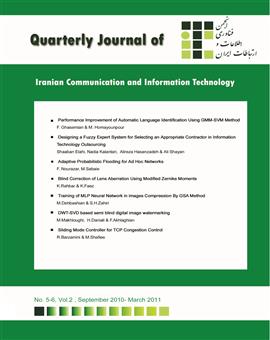Sliding mode control for congestion in TCP/IP networks
Subject Areas : General
roohollah barzamini
1
*
,
masoud shafiee
2
![]()
1 -
2 -
Keywords:
Abstract :
Congestion phenomenon is one of the important problems faced by computer network designers and in recent years it has reduced the efficiency of networks. So far, various methods have been proposed to prevent and control this phenomenon, which are based on control theory. For this purpose, the closed loop structure of the data transfer process in computer networks can be considered in such a way that the controllers from the Dynamic Queue Management (AQM) family are designed to be implemented in the pathfinders of the network and the rest of the network from the point of view of the pathfinder. It is defined as the control target system or plant. In the field of AQM controller design, many researches have been done and many controllers have been designed. In this article, sliding mode control is introduced as AQM controller. Sliding mode control is resistant to modeling uncertainties and disturbances. In sliding mode control, mode paths must reach a predefined level (sliding level) in a limited period of time and remain at the same level over time. Movement on the sliding surface is independent of uncertainties; Therefore, this technique is one of the resistant control methods. After implementing the sliding mode control on the network model, with the help of Matlab software, how the network behaves in the presence of this The controller was examined and the results obtained were compared with the results of several other controllers.
[1] Nagle J., "Congestion Control in IP/TCP Internetworks", RFC 896, FACC, January 1984.
[2] Jacobson V., Karels M. J. Congestion Avoidance and Control (1988). Proceedings of the Sigcomm '88 Symposium, vol.18(4): pp.314–329. Stanford, CA. August, 1988. This paper originated many of the congestion avoidance algorithms used in TCP/IP.
[3] Barzamini R., Shafiee M. (2011). LMI Based Switching Congestion Controller for Multiple Bottleneck Packet Switching Networks. Journal of American Science, 2011;7(6), pp. 254-261.
[4] Hollot C.V., Misra V., Towsley D., Gong W.B., Analysis and design of controllers for AQM routers supporting TCP flows, IEEE Transactions on Automatic Control 47 (6) (2002) 945-959.
[5] Barzamini R., Shafiee M. (2011). Adaptive Generalized Minimum Variance Congestion Controller for Dynamic TCP/AQM Networks. Accepted for publication in Elsevier Journal of Computer Communications (COMCOM).doi:10.1016/j.comcom.2011.08.010.
[6] Fengyuan Ren, Chuang Lin, and Xunhe Yin, "Design a congestion controller based on sliding mode variable structure control," Computer Communications, vol. 28, pp. 1050-1061, 2005.
[7] Zinober, A.S.I., ed (1990). Deterministic control of uncertain systems, London: Peter Peregrinus Press. ISBN 978-0863411700.
[8] Hassan K. Khalil, Nonlinear Systems, 3rd ed. New Jersey, Upper Saddle River: Prentice Hall, 2002.
[9] V. Misra, W.B. Gong, and D. Towsley, “Fluid-based Analysis of a Network of AQM Routers Supporting TCP Flows with an Application to RED”, Proceedings of ACM/SIGCOMM, pp. 151–160, 2000

